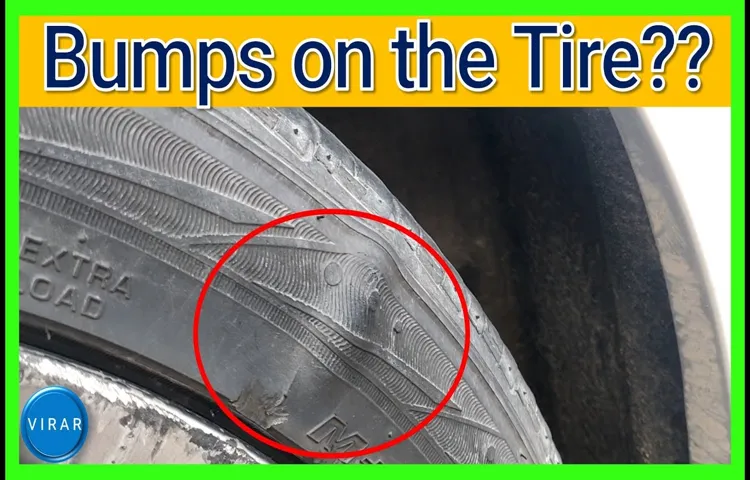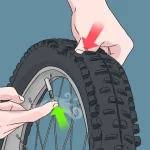You’re driving along, minding your own business, when suddenly you feel a thud coming from your tires. You might start wondering, “what on earth is that?” Well, it could be tire lumps. Tire lumps are unsightly and can be a source of concern for many drivers.
But what do they mean and are they dangerous? In this article, we’ll be diving into everything you need to know about tire lumps and what they can tell you about your vehicle’s health. So buckle in and let’s get started!
Table of Contents
Understanding Tire Anatomy
If you notice a lump on your tire, it could indicate that there’s something wrong with the tire’s structure. More specifically, the lump could mean that the tire has a bulge, which occurs when the internal layers of the tire separate and cause a soft spot. This can happen due to a number of reasons, such as over-inflation, hitting a curb or pothole, or just from general wear and tear.
It’s important to address a bulging tire as soon as possible, as it can lead to a blowout or even an accident. So, if you notice a lump on your tire, be sure to have it inspected by a professional mechanic to avoid any potential dangers on the road.
Explaining Tire Construction and Tire Anatomy
Tire anatomy is an important topic to understand for drivers because it can affect the performance and safety of their vehicle. The construction of a tire includes several key components, starting with the bead that holds the tire onto the wheel rim. The body ply, made of layers of fabric or steel, provides the strength of the tire.
The tread, which is the part of the tire that makes contact with the road, is designed to provide grip and handling in different driving conditions. Other important features include the sidewall, which provides additional support and protection, and the shoulder, which connects the tread to the sidewall. It’s important to choose a tire that’s appropriate for your vehicle and driving conditions, as well as to monitor and maintain your tires regularly to ensure they’re in good condition.
By understanding the anatomy of your tires, you’ll be better equipped to make informed decisions about tire selection and maintenance.

Diagnosing Tire Lumps
If you happen to notice a lump on your tire, it’s important to address it right away. This lump might indicate that there is something seriously wrong with your tire. Lumps can form on your tires as a result of many factors, such as impact damage, belt separation, misaligned wheels, and more.
One of the most common reasons for lumps in your tires is damage to the internal steel belts that support the tire’s structure. If these belts are damaged or broken, it can cause the tire to lose its shape, leading to a noticeable lump. In some cases, a larger lump may also develop along the tire wall, which can be an indication of a serious problem that needs immediate attention.
In any case, if you notice a lump on your tire, it is best to have it inspected by a professional mechanic to see what the problem might be. Don’t risk your safety by driving on a compromised tire, as it could lead to sudden blowouts or even accidents.
Spotting the Signs of a Tire Lump
If you’re experiencing unusual vibrations or a wobbling sensation while driving, your tires might have lumps. These lumps may appear as bulges or bubbles on the tire’s surface and can be caused by a variety of factors, including manufacturing defects, punctures, or impact damage. If left unnoticed, tire lumps can significantly increase your risk of a blowout or tire failure.
You can diagnose a tire lump by visually inspecting the tire and feeling for any irregularities while driving. If you’re uncertain, take your car to a professional mechanic, who can detect and repair the problem before it worsens. Remember, regularly inspecting and maintaining your tires is crucial for your safety and the longevity of your vehicle.
What Causes a Tire Lump?
Have you ever noticed a lump on your tire and wondered what caused it? Well, the reasons for tire lumps can vary depending on various factors, such as tire pressure, weight distribution, and road conditions. Tire lumps can be caused by overloading a vehicle, which puts excessive stress on the tires, resulting in warping and uneven wear. Additionally, low tire pressure can cause a tire to bulge, leading to tread separation and blowouts.
Road hazards, such as potholes or debris, can also damage tires and lead to lumps. Other factors like driving habits and tire age can increase the risk of tire issues, making it essential to give your tires regular inspections and maintenance. Therefore, to avoid tire problems that can put you and other road users in danger, keep a check on your tire pressure, weight distribution, and road conditions.
And in case you notice any lumps or unusual wear on your tires, take them to a professional to diagnose and solve the issue as soon as possible.
Safety Measures with Tire Lumps
If you notice a lump on your tire, it could be a sign of serious damage. A tire lump is usually a bulge on the sidewall of the tire and can indicate that the internal structure of the tire has been compromised. This can be caused by a number of factors, including overloading the tire, hitting a pothole, or even manufacturing defects.
If you continue to drive with a tire lump, the tire could potentially fail, leading to a dangerous blowout that could cause serious damage to your vehicle or even lead to an accident. When you notice a tire lump, it’s important to have your tire checked by a professional as soon as possible to determine the cause and take appropriate action. This could mean replacing the tire entirely or simply repairing the damage, depending on the severity of the problem.
Always prioritize safety and have your tires inspected regularly to avoid any potential hazards on the road.
Why You Shouldn’t Ignore a Tire Lump
When it comes to taking care of your car, one of the most important things to keep an eye on is your tires. Not only can worn or damaged tires affect your car’s performance and fuel efficiency, but they can also be a major safety hazard. One issue that many drivers overlook or ignore is a lump or bulge on their tire.
This can be caused by a variety of factors, including hitting a curb or pothole, or simply from wear and tear over time. However, no matter the cause, it’s important not to ignore a tire lump. Continuing to drive on a damaged tire can increase the risk of a blowout or other serious accident.
If you notice a lump or bulge on your tire, take your car to a mechanic right away to have it inspected. Don’t put your safety at risk – take care of your tires and they’ll take care of you.
How to Safely Replace Your Tires
Replacing your tires can greatly improve the safety and performance of your vehicle. However, it is important to take some safety measures when dealing with tire lumps. First of all, make sure to remove any sharp objects or debris from the area around the tires before beginning.
You should also make sure that your vehicle is parked on a flat surface and the emergency brake is engaged. To prevent any accidents, use a jack and jack stands to firmly support the vehicle. When replacing a tire, never exceed the maximum weight capacity of your vehicle’s jack stands.
If you are unsure about any of these steps, seek the help of a professional. Remember that taking the necessary safety precautions can help prevent accidents and ensure a smooth replacement process.
Preventing Tire Lumps
Have you ever noticed a bump or lump on your tire? This can be a sign of tire separation, which can be dangerous if left unaddressed. Tire separation occurs when the layers of the tire start to come apart, which can lead to a blowout or loss of control while driving. To prevent tire lumps and separation, it’s important to properly maintain your tires.
This includes regularly checking the air pressure, inspecting the tread for wear, and having your tires balanced and aligned as needed. It’s also important to avoid overloading your vehicle or putting excessive strain on your tires, as this can accelerate wear and tear. By taking these steps, you can help ensure that your tires stay in good condition and avoid the risk of tire separation.
So, if you notice any bumps or lumps on your tires, be sure to have them inspected by a professional right away to prevent any further damage.
Tips for Avoiding Tire Lumps
Tire lumps are a common issue that can result in dangerous driving conditions and expensive repairs. The good news is that there are simple steps you can take to prevent tire lumps from occurring. One of the most important things you can do is to regularly check your tire pressure and maintain the recommended levels.
Overinflated or underinflated tires are more susceptible to developing lumps, so it’s crucial to ensure they are properly inflated. Additionally, avoid hitting potholes and hazards on the road whenever possible, as this can cause damage to your tires. Lastly, be sure to rotate your tires regularly to ensure even wear and tear.
By following these tips, you can help prevent tire lumps and ensure your safety on the road. Remember, a little preventative maintenance can go a long way in avoiding costly and potentially dangerous issues down the line.
Maintaining Your Tires for Longevity
Preventing Tire Lumps is an essential step for maintaining the longevity of your tires. Tire lumps or bulges occur when the tire’s inner lining is damaged, causing air to seep into the outer layer of the tire. These lumps can cause uneven wear on your tires, leading to reduced traction, decreased fuel efficiency, and even tire blowouts.
To avoid tire lumps, it’s crucial to regularly inspect your tires, checking for any visible signs of damage such as punctures, cuts, or bulges. Additionally, maintaining correct air pressure, avoiding overloading your vehicle, and driving carefully and avoiding potholes can all help prevent tire lumps. By taking simple steps to prevent tire lumps, you can significantly prolong the life of your tires, keeping you safe on the road for longer while saving you money in the long run.
Conclusion
So, what does it mean when your tire has a lump? Well, it’s quite simple really. It means that your tire is going through a growth spurt! Just like teenagers getting taller, tires sometimes develop lumps as they age and wear down. But unlike teenagers, you don’t want to ignore these lumps.
They can be a sign of underlying issues and should be checked out by a professional. So, don’t procrastinate, get your lumpy tire checked out and keep on rolling smoothly down the road!”
FAQs
What causes a lump on a tire?
A lump on a tire could be the result of damage to the tire, like hitting a curb or pothole, or it could be a manufacturing defect.
Can you drive on a tire with a lump?
It is not recommended to drive on a tire with a lump as it can cause the tire to fail and potentially lead to a dangerous situation.
How can I check if my tire has a lump?
To check if your tire has a lump, inspect the sidewalls and treads for any irregular bulges or bumps. You can also run your hand along the tire to feel for any abnormalities.
How should I address a tire lump?
If you notice a lump on your tire, it’s best to have it inspected by a professional immediately. Depending on the severity of the lump, the tire may need to be replaced.
Can a tire lump be repaired?
In some cases, a tire lump can be repaired, but it depends on the severity and location of the lump. It’s always best to consult with a professional tire technician.
Will a tire lump affect my vehicle’s performance?
Yes, a tire lump can cause your vehicle to shake or vibrate while driving, which can impact its overall performance.
How do I prevent a tire from developing a lump?
To prevent a tire from developing a lump, make sure to properly inflate your tires, avoid driving over potholes and curbs, and regularly inspect your tires for any damage.



